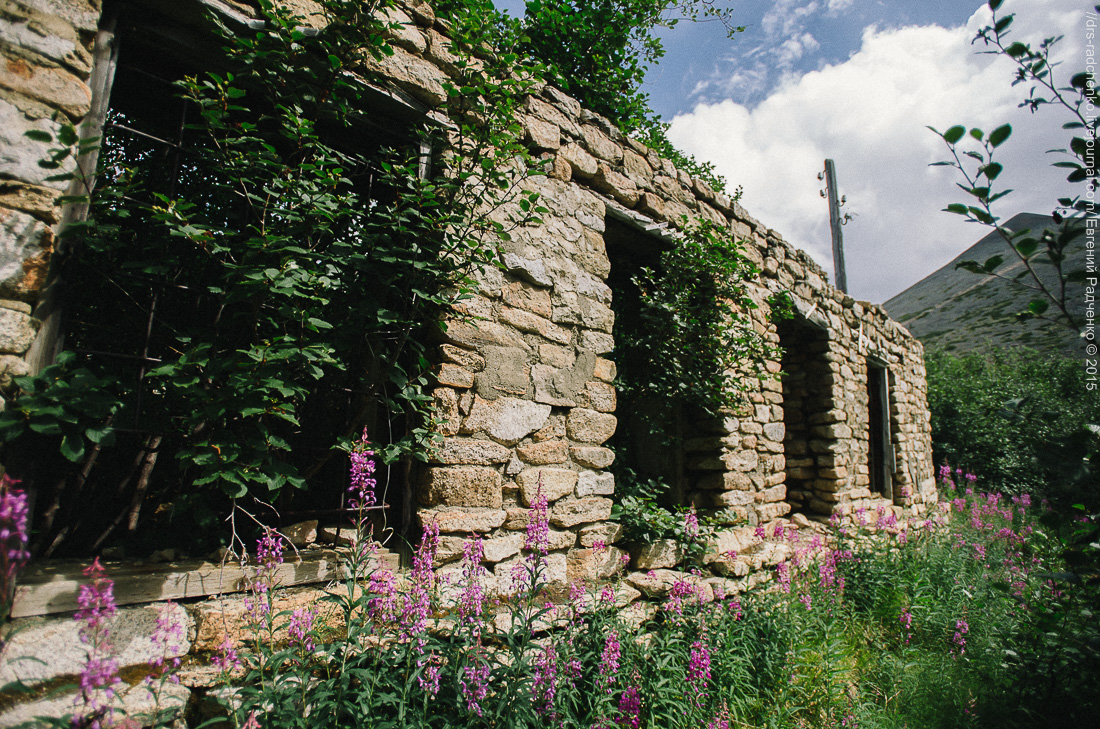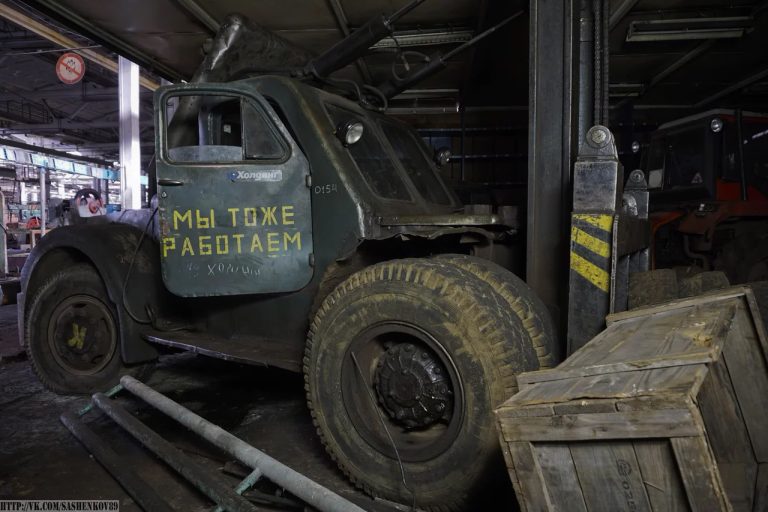A uranium mine on the Kolyma River
At the 222 kilometer post (mile 138) of the Tenkinskiy Route near the Kolyma River there is a brightly colored sign warning about radiation. Yes, there is radiation here. 70 years ago thousands of labor camp convicts worked here.
For reference:
Some of the most harsh labor camps in the USSR were located in the Kolyma region.
In 1928, large gold deposits were found on the Kolyma River. By 1931, the government of the USSR had made a decision to develop these deposits using the labor of prisoners.
All the camps were disbanded in the year 1960.

Early in the morning, having got ready at one of the turns of the road, we climbed into the back of an off-roader truck and drove down and abandoned road to the processing plant of the Butugychag mine hoping to go as close as it was possible to go in a vehicle to the derelict mines.
For reference:
The local name, “Butugychag”, is translated as “The Devil’s Valley” or “Death Valley”.
We passed the power plant building that is a couple kilometers (1,3 miles) away from the main road.

The creek following the road gradually becomes a deep river.



The building of the processing plant, like all the other surviving labor camp structures, is made of natural stone.


The huge territory was fenced with barbed wire.


All the slopes of nearby hills are covered in exploratory trenches.

A creek that turns into a full-flowing river during rainy months is now where the road leading to Upper Butugychag used to be.


Detours and a search for the outgrown road went on until dark.

Then the moment came where the truck had to stop. A precipice was in the way, impossible to pass. The most recent seasonal flood had completely destroyed the road.

In the end, we managed to get to the Centralniy camp. The next day, after breakfast, that was where we headed.

The uraniferous ore that came from Butugychag was transported to Magadan in bags under heightened security. The ore was loaded on a submarine that sailed through the Tatar Strait to Vladivostok, where the strategic material was reloaded on planes and transported to Moscow. The raw material was processed at a special plant in the Moscow region.
The excavation at the mine was the result of forced labor of thousands of prisoners. From here some parts of the Sopka camp can be seen. We’ll get there soon.

“There was no doubt – our prisoner transport was headed to the Kolyma. Even in other camps the Kolyma camps stood for something especially dreadful and fatal. Those who had been there were regarded as if they had miraculously escaped from hell. They were so few that they were nicknamed ‘Kolyma’, and nobody used their first name. Everybody knew who they were anyway”.
From Gorchakov: Memories




“HSB… the high security barrack. A large prison on the camp grounds built of natural stone.
I am describing the prison in the main camp of Butugychag- the Centralniy. There were numerous cells inside the HSB – larger ones, smaller individual ones, ones with cement floor and ones with wooden floor. There were barred partitions in the hallways, and the doors of the cells were either barred or made of solid steel.
The HSB was located in the very corner of a large territory, under a watch tower equipped with spotlights and a machine gun. The public in the HSB was varied. Mostly they were prisoners who were trying to escape from labor and regime violators. Other crimes also varied greatly – from keeping handmade playing cards to murder”.
From The Uranium Fishing Rod by A. Zhigulin

It is known that one of the barred windows was taken out and put into the local history museum.


“When the outside temperature was warmer than -40 degrees Celcius (-40 degrees Fahrenheit), we were sent to work in the squad 401. That was the number of the HSB squad.
These were the people who were trying to avoid work in the mines. So, if you didn’t want to work underground, where it was warm, you had to go get some fresh air. We — 15 to 20 people — were taken to the end of the mounting.
The working site could be seen from far away. It was the slope of the hill opposite the settlement. All the hills around Butugychag were actually quite tall mountains that looked as if somebody had been throwing granite rocks varying in shape and color to make a pile.
There were two guarding posts with soldiers: one at the foot and the other about 100 meters (approx. 110 yards) uphill. The work consisted in moving large stones from the foot uphill.
The work was extremely hard: you had to walk on huge iced rocks while holding similar ones with worn out cotton-padded mittens. Your hands and feet were freezing; the icy wind was burning the skin on your cheeks. In one day, squad 401 carried a huge pile of rocks up, a whole pyramid of them.
The soldiers, of course, had fires going at their posts. The next day the task was reversed: that very same pile of rocks had to be carried downhill, which wasn’t a tiny bit easier.
So, the myth about Sisyphean labor was actually coming true in the 20th century.
After a couple of months of this work we got severe frostbite, became weak and were begging to go back to the mines”.
From The Uranium Fishing Rod by A. Zhigulin
This is, apparently, the warmest place in the HSB, with a double roof and a big furnace. The bunk beds in the guardroom of the offside shift.


And here are some P-bars. You can see them near the guardhouse of any camp on the Kolyma.





In one of the cells we found this table scribbled on the wall, maybe it used to serve as a calendar for someone.

This pile of boots is the best-known landmark of Butugychag. Maybe it was revealed when the warehouse collapsed.


The view of the Centralnyi labor camp nowadays.

The view of the Centralniy labor camp in the year 1950.

Images by Evgeny Radchenko, reproduced with permission






